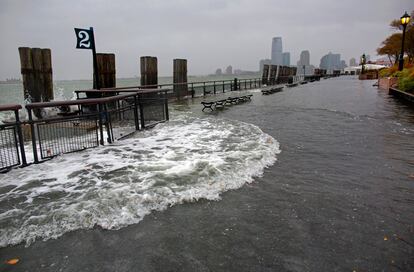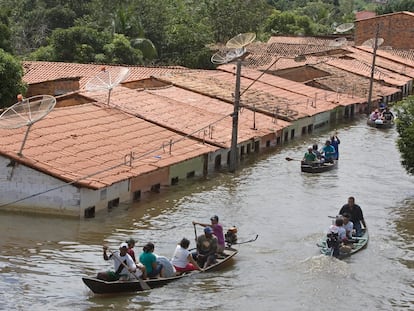As rising oceans threaten NYC, study documents another risk: The city is sinking
New research published this month says the city is sinking at an average rate of 1 to 2 millimeters a year. While the process is slow, investigators say parts of the city will eventually be underwater

If rising oceans aren’t worry enough, add this to the risks New York City faces: The metropolis is slowly sinking under the weight of its skyscrapers, homes, asphalt and humanity itself. New research estimates the city’s landmass is sinking at an average rate of 1 to 2 millimeters per year, something referred to as “subsidence.”
That natural process happens everywhere as ground is compressed, but the study published this month in the journal Earth’s Future sought to estimate how the massive weight of the city itself is hurrying things along.
More than 1 million buildings are spread across the city’s five boroughs. The research team calculated that all those structures add up to about 1.7 trillion tons (1.5 trillion metric tons) of concrete, metal and glass — about the mass of 4,700 Empire State buildings — pressing down on the Earth.
The rate of compression varies throughout the city. Midtown Manhattan’s skyscrapers are largely built on rock, which compresses very little, while some parts of Brooklyn, Queens and downtown Manhattan are on looser soil and sinking faster, the study revealed.
While the process is slow, lead researcher Tom Parsons of the U.S. Geological Survey said parts of the city will eventually be underwater. “It’s inevitable. The ground is going down, and the water’s coming up. At some point, those two levels will meet,” said Parsons, whose job is to forecast hazardous events from earthquakes and tsunamis to incremental shifts of the ground below us.
But no need to invest in life preservers just yet, Parsons assured.
The study merely notes buildings themselves are contributing, albeit incrementally, to the shifting landscape, he said. Parsons and his team of researchers reached their conclusions using satellite imaging, data modeling and a lot of mathematical assumptions.
It will take hundreds of years — precisely when is unclear — before New York becomes America’s version of Venice, which is famously sinking into the Adriatic Sea.
But parts of the city are more at risk.
“There’s a lot of weight there, a lot of people there,” Parsons said, referring specifically to Manhattan. “The average elevation in the southern part of the island is only 1 or 2 meters (3.2 or 6.5 feet) above sea level — it is very close to the waterline, and so it is a deep concern.”
Because the ocean is rising at a similar rate as the land is sinking, the Earth’s changing climate could accelerate the timeline for parts of the city to disappear underwater.
“It doesn’t mean that we should stop building buildings. It doesn’t mean that the buildings are themselves the sole cause of this. There are a lot of factors,” Parsons said. “The purpose was to point this out in advance before it becomes a bigger problem.”
Already, New York City is at risk of flooding because of massive storms that can cause the ocean to swell inland or inundate neighborhoods with torrential rain.
The resulting flooding could have destructive and deadly consequences, as demonstrated by Superstorm Sandy a decade ago and the still-potent remnants of Hurricane Ida two years ago.
“From a scientific perspective, this is an important study,” said Andrew Kruczkiewicz, a senior researcher at Columbia University’s Climate School, who was not involved in the research.
Its findings could help inform policymakers as they draft ongoing plans to combat, or at least forestall, the rising tides.
“We can’t sit around and wait for a critical threshold of sea level rise to occur,” he said, “because waiting could mean we would be missing out on taking anticipatory action and preparedness measures.”
New Yorkers such as Tracy Miles can be incredulous at first.
“I think it’s a made-up story,” Miles said. He thought again while looking at sailboats bobbing in the water edging downtown Manhattan. “We do have an excessive amount of skyscrapers, apartment buildings, corporate offices and retail spaces.”
New York City isn’t the only place sinking. San Francisco also is putting considerable pressure on the ground and the region’s active earthquake faults. In Indonesia, the government is preparing for a possible retreat from Jakarta, which is sinking into the Java Sea, for a new capital being constructed on the higher ground of an entirely different island.
Sign up for our weekly newsletter to get more English-language news coverage from EL PAÍS USA Edition
Tu suscripción se está usando en otro dispositivo
¿Quieres añadir otro usuario a tu suscripción?
Si continúas leyendo en este dispositivo, no se podrá leer en el otro.
FlechaTu suscripción se está usando en otro dispositivo y solo puedes acceder a EL PAÍS desde un dispositivo a la vez.
Si quieres compartir tu cuenta, cambia tu suscripción a la modalidad Premium, así podrás añadir otro usuario. Cada uno accederá con su propia cuenta de email, lo que os permitirá personalizar vuestra experiencia en EL PAÍS.
¿Tienes una suscripción de empresa? Accede aquí para contratar más cuentas.
En el caso de no saber quién está usando tu cuenta, te recomendamos cambiar tu contraseña aquí.
Si decides continuar compartiendo tu cuenta, este mensaje se mostrará en tu dispositivo y en el de la otra persona que está usando tu cuenta de forma indefinida, afectando a tu experiencia de lectura. Puedes consultar aquí los términos y condiciones de la suscripción digital.
More information
Archived In
Últimas noticias
Maduro pleads not guilty before the federal court in New York: ‘I am still the president of Venezuela’
A new test can detect Alzheimer’s from a finger prick
UN team enters Sudanese city of El Fasher after paramilitary massacre: ‘It’s like a ghost town’
A recipe for resistance: Indigenous peoples politicize their struggles from the kitchen
Most viewed
- Gilles Lipovetsky: ‘If you want to live better and fall in love, take Prozac, don’t look to philosophy’
- Alain Aspect, Nobel laureate in physics: ‘Einstein was so smart that he would have had to recognize quantum entanglement’
- Alvin Hellerstein, a 92-year-old judge appointed by Bill Clinton, to preside over Maduro’s trial in New York
- Maduro’s downfall puts China’s relationship with Venezuela to the test
- Why oil has been at the center of Venezuela-US conflicts for decades










































